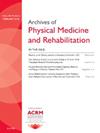Autonomic Function Comparison Between Unvaccinated and Vaccinated Young Adults Infected with COVID-19: An Observational Study 4346
IF 3.6
2区 医学
Q1 REHABILITATION
Archives of physical medicine and rehabilitation
Pub Date : 2025-04-01
DOI:10.1016/j.apmr.2025.01.032
引用次数: 0
Abstract
Objectives
To compare heart rate variability (HRV) indexes between coronavirus disease 2019 (COVID-19) infected unvaccinated (UYA) and vaccinated young adults (VYA).
Design
Observational study evaluating differences in HRV between COVID-19 infected vaccinated and UYA.
Setting
General community of young adults infected with COVID-19 in São Paulo state, Brazil.
Participants
Twenty-three UYA and 10 VYA with mild to moderate clinical COVID-19 were evaluated. Eligibility criteria: men and women, 20-40 years. Recruitment was through the media and diagnosis was via polymerase chain reaction test. Mean age of UYA was 29.17±6.32 and 26.22±5.23 years for VYA. HRV indexes were measured via heart monitor (Polar RS800CX) and this took place in a quiet room maintained at room temperature following at least 24 hours of complete abstinence from exercise, alcohol, and caffeine intake. Participants were fitted with a chest strap for 25 minutes and HRV was performed on 256 consecutive intervals and of these the most stable tachogram was selected. The indexes are divided into time domain, frequency domain, and nonlinear variables. The major indexes of note were mean heart rate (HR), stress index, low frequency power (LF) representing sympathetic system; mean RR interval, high frequency power representing the parasympathetic system and low frequency power/high frequency power representing global variability (overall well-being).
Interventions
Not applicable.
Main Outcome Measures
HRV indexes of infected unvaccinated and vaccinated subjects.
Results
Statistically significant differences were observed only in mean HR and mean RR interval. UYA (83.5±12.6bpm) had higher mean HR compared with VYA (73.9± 4.91bpm); P=.004; mean difference (MD), −9.58±4.15 bpm; confidence interval, 3.34-15.81. Mean RR was higher in VYA (812.90±52.06ms) than UYA (735.43±123.78ms); P=.02; MD, −77.47±30.6 ms; confidence interval, −139.90 to −15.03. Although the above 2 variables indicate sympathetic and parasympathetic systems, respectively, other indexes were not statistically significant. Most indexes evaluating sympathetic and parasympathetic systems activities were not different between the groups, except for mean HR and RR.
Conclusions
This study suggests that vaccination could help to establish and maintain better autonomic function (lower mean HR and higher mean RR interval) after COVID-19, further experimental research is needed to establish a causal relationship.
Disclosures
none.
未接种疫苗和接种疫苗的年轻成人感染COVID-19的自主神经功能比较:一项观察性研究
目的比较2019冠状病毒病(COVID-19)感染未接种疫苗(UYA)和接种疫苗的年轻人(VYA)的心率变异性(HRV)指标。目的:观察性研究评估COVID-19感染疫苗和UYA之间HRV的差异。巴西圣保罗州感染COVID-19的年轻成年人一般社区。对临床轻至中度COVID-19的23例UYA和10例VYA进行评估。入选标准:男女,年龄20-40岁。通过介质招募,通过聚合酶链反应试验诊断。UYA的平均年龄为29.17±6.32岁,VYA的平均年龄为26.22±5.23岁。HRV指数通过心脏监测仪(Polar RS800CX)测量,在一个保持室温的安静房间里进行,至少24小时完全停止运动、酒精和咖啡因的摄入。参与者佩戴胸带25分钟,并在256个连续间隔内进行心率波动,从中选择最稳定的速度图。指标分为时域、频域和非线性变量。主要观察指标为平均心率(HR)、应激指数、代表交感神经系统的低频功率(LF);平均RR间隔,高频功率代表副交感神经系统,低频功率/高频功率代表全局变异性(整体幸福感)。InterventionsNot适用。主要观察指标感染未接种者和接种者的shrv指数。结果两组间仅平均HR和平均RR间期差异有统计学意义。UYA(83.5±12.6bpm)的平均心率高于VYA(73.9±4.91bpm);P = 04;平均差(MD),−9.58±4.15 bpm;置信区间为3.34-15.81。VYA组的平均RR(812.90±52.06ms)高于UYA组(735.43±123.78ms);P = .02点;MD,−77.47±30.6 ms;置信区间为−139.90 ~−15.03。虽然以上两个变量分别表示交感和副交感神经系统,但其他指标均无统计学意义。除平均HR和RR外,其他评估交感和副交感系统活动的指标在两组间无显著差异。结论本研究提示接种疫苗有助于建立和维持较好的自主神经功能(较低的平均HR和较高的平均RR区间),两者之间的因果关系有待进一步的实验研究。
本文章由计算机程序翻译,如有差异,请以英文原文为准。
求助全文
约1分钟内获得全文
求助全文
来源期刊
CiteScore
6.20
自引率
4.70%
发文量
495
审稿时长
38 days
期刊介绍:
The Archives of Physical Medicine and Rehabilitation publishes original, peer-reviewed research and clinical reports on important trends and developments in physical medicine and rehabilitation and related fields. This international journal brings researchers and clinicians authoritative information on the therapeutic utilization of physical, behavioral and pharmaceutical agents in providing comprehensive care for individuals with chronic illness and disabilities.
Archives began publication in 1920, publishes monthly, and is the official journal of the American Congress of Rehabilitation Medicine. Its papers are cited more often than any other rehabilitation journal.

 求助内容:
求助内容: 应助结果提醒方式:
应助结果提醒方式:


